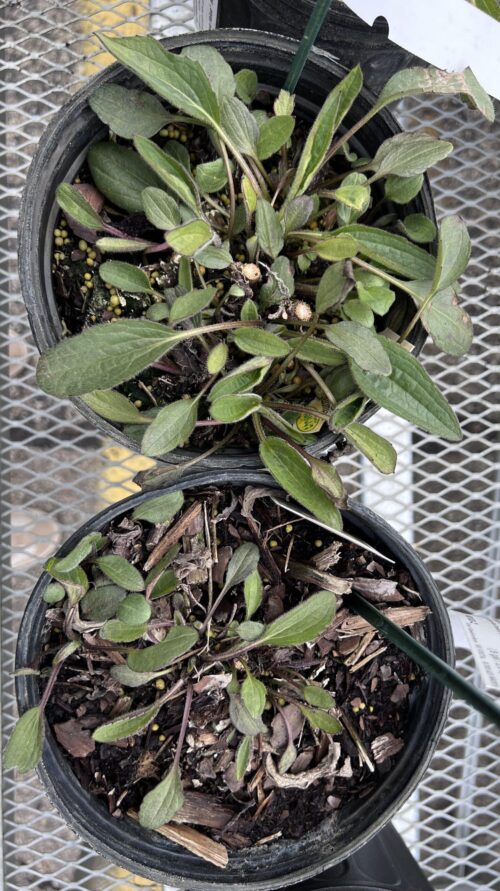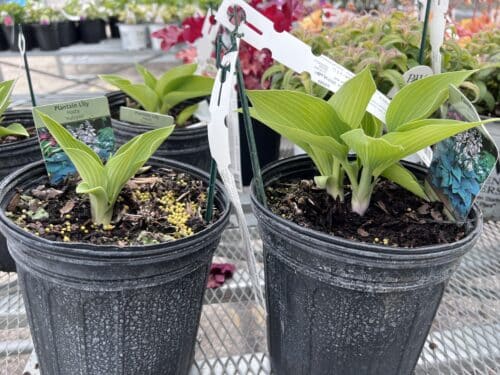There are two types of plant shoppers: the kind who spots the variety they are looking for and they grab the first one they see and the kind who will look through a minimum of a dozen plants before choosing the one.
It’s pretty clear what category I fall into. I have never purchased the first plant I picked up in my life.
But it’s not about a certain level of OCD. It’s because some plants are definitely better than others.
Here’s what you should look for when selecting a plant to take home from the garden center.
Annuals
Annuals are often crammed on benches in trays, so you’ll have to remove a pot from the tray to really check it out. Plants toward the center of the tray are often smaller than others just because there’s less room there.
- Look for a full pot. You want a plant that’s had some time in the pot, not a recently potted-up plug.
- Branching and bushiness. A well-grown annual will have multiple branches and is a tight clump, rather than a loose series of stems. This is a sign that the grower has been pinching it back to help create a fuller plant.
- Buds not blooms. The ideal annual has a lot of buds and one flower blooming. I like to see one flower just to make sure it’s the right plant because mislabeling happens. But if that perfect plant isn’t available, I’ll take buds over blooms any day because I want to be the one who enjoys a big flush of flowers.
- The right weight. Pick up the pot and see if the weight feels right. If it’s light it’s likely dry and underwatered and you should put that right back on the table. If it’s too heavy it may be overwatered and sodden. This is a Goldilocks situation: you want want that’s just right.
Perennials
- If given the choice, try not to buy perennials that are flowering. Producing flowers requires energy, and the process of transplanting can be stressful. Also, just like with annuals, you want to see the plant bloom in your garden, not in the nursery.
- Check out the soil in the pot. Perennials are often potted into bigger cans as they grow, and of course the bigger the pot, the higher the price. This can be worth it if the plant has grown enough to fill out that pot, but you don’t want to buy a gallon-size perennial that was just potted up from a 4-inch pot a week ago.
- Check the roots. Buying a plant that’s been in a pot too long is not good either, so check if a plant is rootbound. It’s OK to gently tip plants over and squeeze the pot to slide the root ball out. If you see masses of roots growing in a circle, move on to a different plant. Regardless of which plant you pick, make sure to slide them back into the pot and then gently tap the pot on the bench to make sure the root ball is nicely seated in the pot.

4. Look for the number of shoots. I’d rather see more stems emerging from the crown that one larger one.

Shrubs
- Roots not shoots. Top growth on shrubs is often pruned off at nurseries, so a better indication of maturity and size is the root ball. Smaller root balls are easier to plant and usually faster to establish but larger root balls offer more instant gratification.
- Check the structure. When you get into woody plants, the formative years are important, so look for good, even, aesthetically pleasing branching.
- Be wary of plants that seem to be leafed out early. It’s likely that these came from nurseries with warmer climates than your own and you’ll have to baby them through cold weather, should it come early in the season. If you get them through that phase, they’ll be fine.
Trees
- Do the roots match the shoots? Be suspicious of trees with a large canopy or a very tall leader with a small root system. There’s a chance that the roots may have been dramatically cut in the harvesting process.
- If you’re buying a containerized tree, it would be great if you can get a peek at the roots to make sure they aren’t circling, which is very common. But it’s very difficult to accomplish that, so look for a sign that the pot is bulging and avoid it.
- Branching is key. Good tree growers prune for appropriate branching (and it’s usually worth paying more for a tree grown like this).
- Watch for the bad stuff. Look for wounds from crossing branches or other damage and move on.

